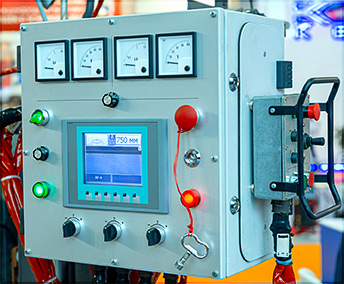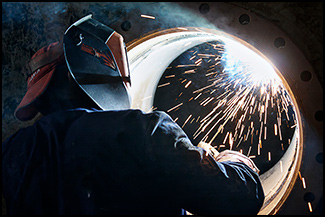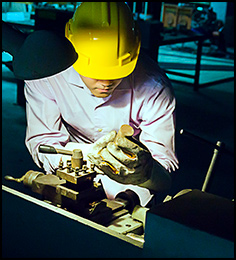Our last post walked us through the history of welding and took a peek at how it works with Industry 4.0. Today, we're looking at how robotic welding advantages show great potential in improving workflows.
Today, we're focusing on robotic welding: its advantages and strengths.
Businesses of all sizes reap benefits from using robotic welding.
Advantages of Robotic Welding
Here are the most common benefits of using a robotic welding program:
Consistency and Repeatability
 Skillful manual welding has a single flaw: the human aspect. Despite a person's skill set and work ethic, there's a struggle with producing repeatable and consistent welds over time. Robotic welders work up to five times faster than humans. People, on the other hand, have speed limitations. The quicker people work, the higher the chance of mistakes.
Skillful manual welding has a single flaw: the human aspect. Despite a person's skill set and work ethic, there's a struggle with producing repeatable and consistent welds over time. Robotic welders work up to five times faster than humans. People, on the other hand, have speed limitations. The quicker people work, the higher the chance of mistakes.
Robotic welders have no such drawback; they move faster between weld joint positions and withstand higher arcs on time. Programming the welder makes working 24/7 at the same weld cycle possible.
Increased Quality, Decreased Weld Distortion
Robotic welders not only work faster than humans, they're more accurate, too. Better and faster welds result in higher-quality work.
Significant metal distortion is caused when the weld metal expands and contracts during the welding process. The metal distorts when the two welded metals heat and cool during the welding process.
Robotic welders always use the correct size weld for joint requirements, minimize the number of weld passes, and reduce the overall welding task. This combination reduces the chances of any welding distortion.
 Safety
Safety
Using robotic welding also makes the work environment safer for employees. Exposure to flash burns to the cornea, electrical shock, toxic fumes, and gases reduces accidents yearly.
Saves Production Costs
Because robotic welding is so precise, it uses precise material amounts, eliminating the chances of overestimating weld sizes. Robotic welding also delivers components at a reduced cost because of the cumulative savings from its consistency, productivity, and quality.
This statement sounds harsh, but a robotic welder doesn't need health benefits or salary and uses less energy than a person.
Skilled Welder Shortage
 Demand for skilled welders is quickly rising, but there are not enough people to meet it. Quoting an article from Bloomberg Businessweek, the AWS estimates a shortage of nearly 300,000 welders in the U.S. by 2020.
Demand for skilled welders is quickly rising, but there are not enough people to meet it. Quoting an article from Bloomberg Businessweek, the AWS estimates a shortage of nearly 300,000 welders in the U.S. by 2020.
That was one of the facts revealed in a recent story by Bloomberg Businessweek. The story looked at the growing demand for welders. Specifically, it looked at how the profession is now an excellent opportunity for young people who want to learn a skilled trade.
Since the recession ended in 2009, manufacturing has grown faster than the rest of the U.S. economy. For the first time in nearly 50 years, manufacturers have added jobs four years in a row. The oil and gas boom further fuels this growth. Thousands of miles of new pipelines are built, and finishing them requires skilled welders.
A solution in Sight?
According to Monica Pfarr's writing at Fabtech, the manufacturing industry is working to increase the number of qualified welders in the U.S.
The urgent need for more welders and higher skill levels among welding personnel is widely known and accepted in the U.S. manufacturing industry. However, parents, career counselors, and students graduating from secondary school have no idea this issue exists.
Shortage Contributors
When experienced welders retire, typically, their replacements are inexperienced entry-level welders. According to MetalSkills, 50% of all people applying for welding jobs get turned away. Primarily because of a lack of proper skill and training in welding. Eventually, all this adds up to a challenging situation. 80% of manufacturers report they don't have the skilled workers to stay competitive in today's world market.
Since welding plays an essential role in many major U.S. industries, this shortage poses a severe problem. For example, much of the U.S.'s energy and transportation infrastructure was constructed back in the 1950s and 60s. It needs updating and maintaining skilled welders. How has this happened?
Part of the reason for this shortage may be that entry-level positions in manufacturing require more education and training than ever. More importantly, welding has been misconstrued for a long time as a dirty, dangerous, and even dead-end job. In 2011, welding was on the list of the top ten worst jobs in America on
Careercast.com!
High school career and technical education programs were mandatory but are now declining. This decline, along with welding-related dangers, leads high school students to pursue a four-year college degree. Because those education programs aren't as vital, any students now interested in trade jobs jump to the workforce once out of high school. Their lack of training adds to the skill gap.
The key is taking advantage of what robotic welding provides in manufacturing. Losing skilled welders because of retirement doesn't create a skill gap in a manual welding shop.
Benefits
 When connected to the IoT, robotic welders provide a couple of significant benefits, such as fault monitoring and preventative maintenance.
When connected to the IoT, robotic welders provide a couple of significant benefits, such as fault monitoring and preventative maintenance.
According to Hitachi Solutions, predictive maintenance sprouted from the IoT for two reasons:
First, modern machinery often comes with embedded computer chips to control the machine and also take readings from these machines. Although the machine owners haven't always stored this data, it is available for them to start capturing.
Second, with new machines, their embedded sensors, and new information technologies for inexpensive capture and storage, the cost (data, effort, and monetary) to implement predictive maintenance has and continues to be significantly reduced.
Since welding works with known settings, any problem deviates voltage or amperage. Flagging any variances detected creates inspection tasks, saving time and resources. Other non-expected failures are also traceable, such as a stuck cap or burnback.
Predictive maintenance (PdM) is trickier but possible. During arc welding, measuring an increase in resistance and track tip wear is an example of programmable PdM.
If properly configured, robotic welding programs not only detect problems but also help keep track of maintenance issues and other errors.
In Sum
It's genuinely cliché, but as our society evolves, we become interconnected like never before. Robotic welding is an example of this evolution.
Modern welding techniques were the primary way of connecting metal. Over 50 years ago, robotic welding cut its teeth on assembly lines in automobile plants using simple programming language.
Robotic welding evolved into a mainstay in the manufacturing process. With benefits ranging from increasing production without compromising quality while helping alleviate a welder's shortage, welding with robotics helps introduce Industry 4.0.